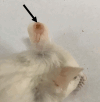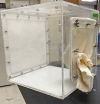Overview and Approaches for Handling of Animal Models of Leishmaniasis
- PMID: 39107941
- PMCID: PMC11267445
- DOI: 10.30802/AALAS-CM-24-029
Overview and Approaches for Handling of Animal Models of Leishmaniasis
Abstract
Leishmaniasis, a disease of global relevance, results from infection with the protozoan parasite, Leishmania, which is transmitted to susceptible hosts through the bite of sand flies. Multiple forms of leishmaniasis may occur, including cutaneous, mucocutaneous, and visceral. Research with animal models remains an important approach to help define basic pathophysi- ologic processes associated with infection and disease. In this regard, mice and hamsters represent the most commonly used models. The severity of leishmaniasis in animal models depends on several factors, including genotype of the host and parasite and the dose and route of administration of the parasite to the host, and severity of outcome may range from subclinical to severe illness. This review provides basic background on leishmaniasis, relevant animal models, the pathophysiology and clinical signs in animals used as models of leishmaniasis, and general approaches to mitigate risk to personnel.
Conflict of interest statement
The authors have no conflicts of interest to declare.
Figures





References
-
- Agu WE, Farrell JP, Soulsby EJL. 1981. Proliferative glomerulonephritis in experimental Leishmania donovani infection of the golden hamster. Comp Immunol Microbiol Infect Dis 4:353–368. - PubMed
-
- Aguilar-Torrentera F, Carlier Y. 2001. Immunological factors governing resistance and susceptibility of mice to Leishmania major infection. Rev Latinoam Microbiol 43:135–142. - PubMed
-
- Ahmed SB, Bahloul C, Robbana C, Askri S, Dellagi KA. 2004. Comparative evaluation of different DNA vaccine candidates against experimental murine leishmaniasis due to L. major. Vaccine 22:1631–1639. - PubMed
-
- Alimohammadian MH, Darabi H, Ajdary S, Khaze V, Torkabadi E. 2010. Genotypically distinct strains of Leishmania major display diverse clinical and immunological patterns in BALB/c mice. Infect Genet Evol 10:969–975. - PubMed
Publication types
MeSH terms
LinkOut - more resources
Full Text Sources
Medical

